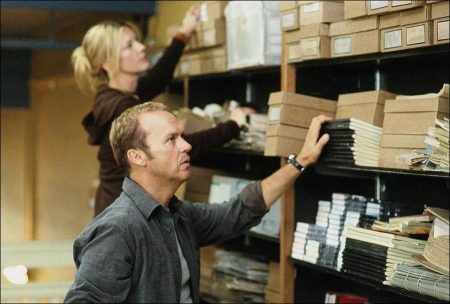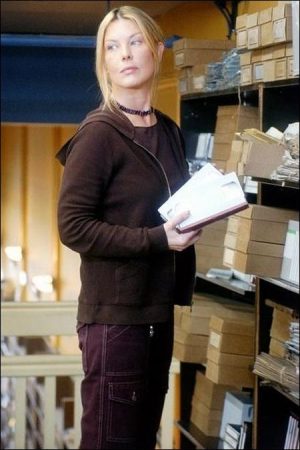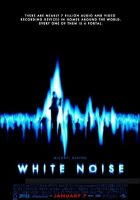Tagline: The voices of the dead are all around you.
White Noise movie storyline. The car of successful author Anna Rivers is found disabled next to the river, the thought being that she accidentally fell into the river while trying to change a flat tire. Her dead body is found upstream several weeks later, consistent with the accidental death theory. Based on incidents around him, her grieving husband, architect Jonathan Rivers, decides several months later to visit with Raymond Price, who approached John prior to Anna’s body being found with news that she was trying to contact him from beyond.
At that time, John was skeptical of Raymond’s claims of electronic voice phenomena (EVP): that he is contacted from the beyond through electronic means – radio, television – which he is able to record. Along with Sarah Tate, another of Raymond’s “clients” whose fiancé passed away, John becomes obsessed with EVP as he gets more and more audio and video messages, however fuzzy, from Anna from beyond. That obsession takes a slight change in focus when John believes that Anna is trying to pass along information to help others.
But the nature of those messages and their connection to Raymond in combination with John learning that not all good comes through EVP leads to the possible belief that he dabbling in EVP in and of itself may be dangerous and the cause of those potentially deadly issues in which he is supposed to assist in helping. John has to decide whether or not to continue with his work in EVP, not continuing which means that he may actually prevent bad things from happening, and continuing which means that he gets his much wanted connection with Anna.
White Noise is a 2005 supernatural horror thriller film, directed by Geoffrey Sax. The title refers to electronic voice phenomena (EVP), where voices, which some believe to be from the “other side”, can be heard on audio recordings. The film is not related to the postmodern novel White Noise by Don DeLillo.
About the Production
The ‘White Noise’ of the title refers to a phenomenon known as EVP (Electronic Voice Phenomena). Listen carefully, believers will tell you, and in amidst the white noise of a detuned radio you might hear voices…and in amidst the white noise of a detuned television, you might see faces. These, they’ll tell you, are the voices and faces of the dead.
Electronic Voice Phenomenon — EVP — is the process by which the dead, through sound and image, communicate with the living through the static and white noise of modern electronic devices. By modest estimates, there are nearly seven billion audio and video recording devices in homes around the world…and every one of them is a portal.
For two decades now, a quiet worldwide movement has gained momentum among the growing number of people who believe in EVP and who themselves have captured extraordinary recordings of communications from the dead. These transmissions, recorded with simple household electronic devices, force us to question our basic notions about life and death and seem to confirm what many of us have dared to believe: it is possible for the dead to communicate with us. All we have to do is listen.
Now, for the first time, this otherworldly occurrence stands at the center of a motion picture paranormal thriller — White Noise.
Until the sudden and mysterious death of his beloved wife, architect Jonathan Rivers (Michael Keaton) considered himself a decent, rational man, one who would not ordinarily subscribe to any theories about communicating with the dead. But now, a stranger, Raymond Price (Ian McNeiceI), has entered his life, claiming to have heard Jonathan’s wife, Anna (Chandra West), through EVP.
Fueled by his grief as much as curiosity, Jonathan soon finds himself swayed by Raymond’s claims, validated by the recordings of Anna as well as the testimonial of Sarah Tate (Deborah Kara Unger), who herself has found closure with her deceased fiancee through EVP. Jonathan comes to believe when Raymond says of the dead, “I can hear them, I can see them and I can record them.”
Then, the unthinkable — Jonathan himself captures Anna’s voice and image through recordings he has made; she has established direct contact. Anna’s message: for Jonathan to save the future victims of the brutal psychopath who took her life. But his dead wife’s communications are often fuzzy, challenging to decipher. And Jonathan, in his growing obsession with reaching Anna, fails to notice signs of impending danger, summed up by Raymond’s assessment of the souls who cross the divide from the other side: “They can’t all be nice.”
What Jonathan hopes to be true is, in fact, possible: our departed loved ones can reach us… but if they can come through, who, or what else, can also come through?
White Noise is a 2005 supernatural horror thriller film, directed by Geoffrey Sax. The title refers to electronic voice phenomena (EVP), where voices, which some believe to be from the “other side”, can be heard on audio recordings. The film is not related to the postmodern novel White Noise by Don DeLillo.
The movie did very well at the box office despite generally poor reviews from both critics and audiences. This success led Universal and other studios to realize that there was an untapped audience for horror films released in January, and began releasing higher-quality horror films during that period, usually dismissed as the winter dump months of the movie calendar.
White Noise (2005)
Directed by: Geoffrey Sax
Starring: Michael Keaton, Deborah Kara Unger, Mike Dopud, Ian McNeice, Chandra West, Keegan Connor Tracy, Sarah Strange, Nicholas Elia, Marsha Regis, Miranda Frigon
Screenplay by: Niall Johnson
Production Design by: Michael S. Bolton
Cinematography by: Chris Seager
Film Editing by: Nick Arthurs
Costume Design by: Karen L. Matthews
Set Decoration by: Penny A. Chalmers
Art Direction by: Greg Venturi
Music by: Claude Foisy
MPAA Rating: PG-13 for violence, disturbing images and language.
Distributed by: Universal Pictures
Release Date: January 7, 2005
Views: 59





